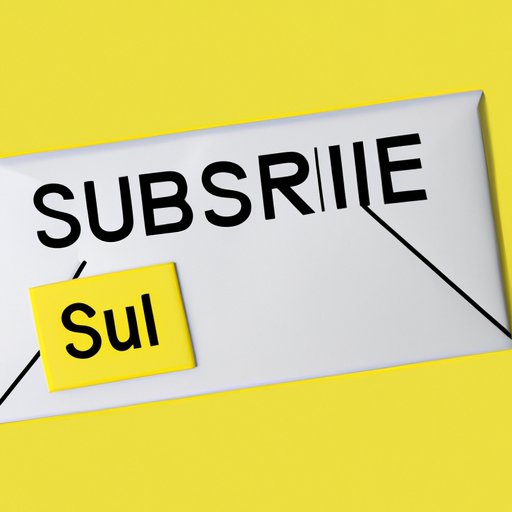
Introduction
Unsubscribing from unwanted emails, newsletters, and other communications is an essential practice to keep your inbox organized and improve your productivity. Not only does it help declutter your inbox, but also prevent spam messages from invading your privacy. In this article, we will provide a detailed step-by-step guide on how to unsubscribe from unwanted emails and explain the benefits of this practice. We will also discuss some dos and don’ts of the process, offer tips on how to minimize spam emails, and suggest some tools and software to help you manage your inbox more effectively. Finally, we will inform you about your legal rights and obligations when it comes to unsubscribing.
Step-by-Step Guide
To unsubscribe from unwanted emails, follow these steps:
- Open the email you no longer wish to receive.
- Scroll to the bottom of the email.
- Look for an “Unsubscribe” link or button.
- Click on the “Unsubscribe” link or button.
- Follow the prompts to confirm your decision.
- You will receive a confirmation message once you are unsubscribed.
If you cannot find an “Unsubscribe” link or button in the email, it may be hidden or disguised. In this case, look for a small font, light-colored, or hard-to-see link at the bottom of the email. If you still cannot find it, try searching for “Unsubscribe” in your email search bar. If all else fails, mark the email as spam or junk, and it will be sent directly to your spam folder in the future.
If you receive a lot of similar emails, such as newsletters or promotional messages, consider using an email management tool or service. Some popular options include Unroll.Me, SaneBox, and Clean Email. These services can automatically detect and unsubscribe from unwanted emails, group similar messages together, and organize your inbox for you.
Benefits of Unsubscribing
Unsubscribing from unwanted emails has numerous benefits:
- It helps you keep your inbox organized and easy to navigate.
- It reduces distractions and interruptions, allowing you to focus on important tasks.
- It prevents spam messages from invading your inbox and potentially compromising your privacy.
- It frees up storage space in your email account.
In short, unsubscribing from unwanted emails can help you save time and increase your productivity, both at work and in your personal life.
Dos and Don’ts of Unsubscribing
Here are some best practices and common mistakes to keep in mind when unsubscribing from unwanted emails:
- Do unsubscribe from emails you no longer want to receive.
- Do use an email management tool or service if you receive a lot of similar emails.
- Do remember that it may take a few days for your unsubscribe request to take effect.
- Don’t mark emails as spam or junk unless they are actually unsolicited or malicious.
- Don’t click on any links or buttons in suspicious emails, as they may contain phishing scams or viruses.
- Don’t re-subscribe to emails you have previously unsubscribed from, unless you are sure you want to receive them again.
To avoid re-subscribing, you can create a separate email account or use a filter rule to automatically delete emails from specific senders. To minimize spam emails, you can avoid giving out your email address online, use a strong and unique password, and be cautious when opening attachments or clicking on links in emails.
Tools and Software
Here are some tools and software that can help you manage your inbox more effectively:
- Unroll.Me: a free service that detects and unsubscribes from unwanted emails, and groups similar messages together.
- SaneBox: a paid service that separates important emails from unimportant ones, and works with multiple email providers.
- Clean Email: a multi-platform service that lets you organize, filter, and delete unwanted emails in bulk.
- Mailbird: a desktop email client that allows you to manage multiple email accounts, unsubscribe from unwanted emails, and reply to messages with templates.
You can also use built-in unsubscribe features in your email provider or client, such as Gmail’s “Report spam” or “Unsubscribe” buttons. These features can help you stay in control of your inbox and prevent unwanted messages from cluttering it.
Legal Obligations
When it comes to unsubscribing, it’s important to be aware of your legal rights and obligations. The CAN-SPAM Act is a law that sets the rules for commercial emails and gives recipients the right to unsubscribe from them.
According to the CAN-SPAM Act, the sender of a commercial email must:
- Include a clear and conspicuous “Unsubscribe” link or button in the email.
- Honor all unsubscribe requests within 10 business days.
- Identify the email as an advertisement, and include the sender’s physical address.
- Use honest and accurate subject lines and headers.
If you receive a commercial email that violates these rules, you can report it to the Federal Trade Commission (FTC) or your email provider. You can also take legal action against the sender if you suffer damages as a result of their actions.
Conclusion
In conclusion, unsubscribing from unwanted emails is a simple yet effective way to keep your inbox organized and minimize distractions. By following the steps we outlined in this article, you can easily unsubscribe from emails you no longer want to receive, and use tools and software to manage your inbox more efficiently. Remember to be cautious when opening emails, avoid re-subscribing to unwanted messages, and know your legal obligations as a recipient of commercial emails. By doing so, you can enjoy a clutter-free and stress-free inbox.




